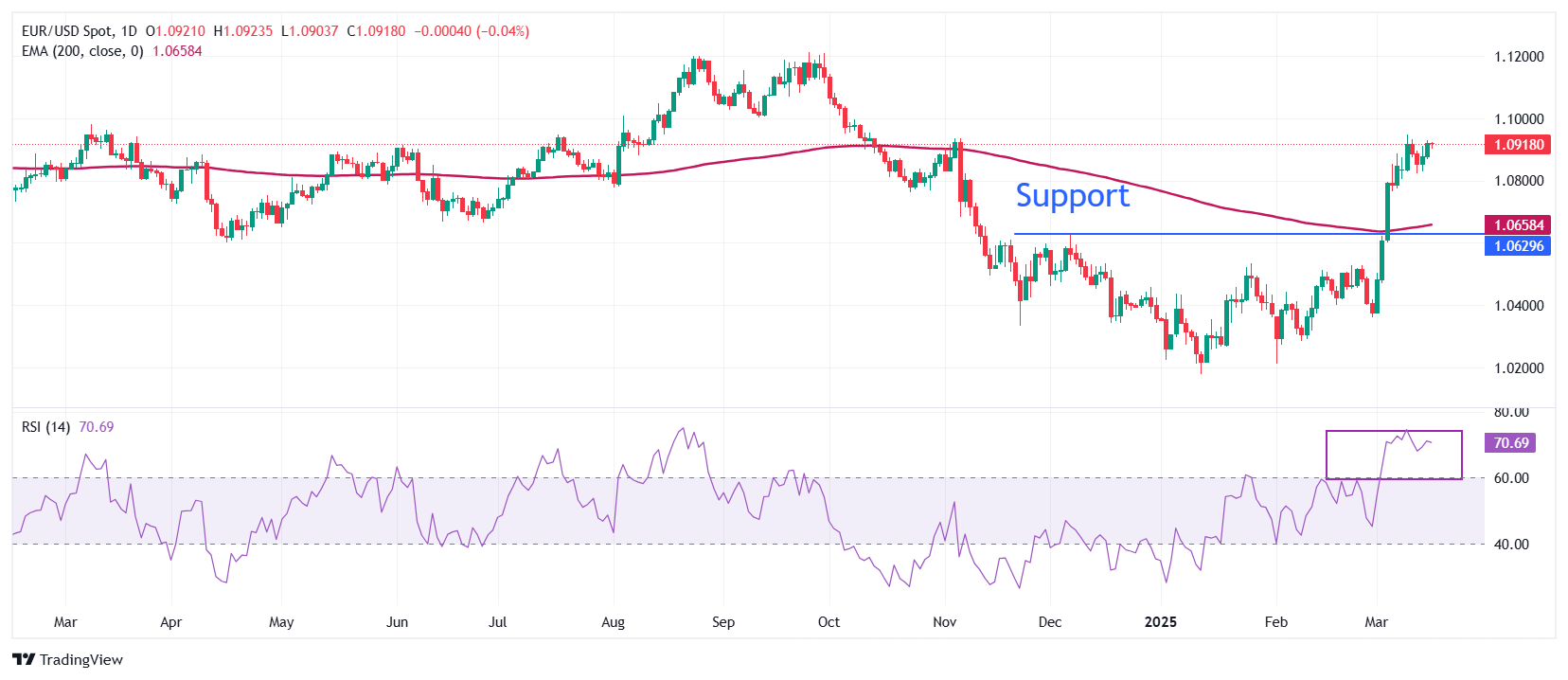- EUR/USD declines from 1.0950 ahead of Germany’s debt restructuring vote and US-Russia peace talks.
- Looser German borrowing rules could stimulate economic growth and job creation.
- The Fed is expected to hold interest rates steady on Wednesday amid uncertainty surrounding Trump’s economic policies.
EUR/USD retreats after hitting a fresh five-month high near 1.0955 in Tuesday’s North American session, as the US Dollar (USD) gains traction ahead of the Federal Reserve’s (Fed) interest rate decision on Wednesday. The US Dollar Index (DXY), which measures the Greenback against six major currencies, recovers from its five-month low of 103.20.
The CME FedWatch tool indicates that the Fed is highly likely to keep interest rates unchanged at 4.25%-4.50% for the second consecutive meeting. Traders remain confident that the Fed will maintain its cautious stance, as officials emphasize a "wait and see" approach amid economic uncertainty under President Trump’s leadership. His proposed reciprocal tariffs, which would match levies imposed by other nations, have raised concerns over inflation and economic volatility.
Market expectations suggest that Trump’s tariff policies could drive inflation higher and create economic instability. Several US officials, including the President, have acknowledged the potential risk of a recession stemming from these measures.
Geopolitical uncertainty linked to Trump's trade agenda has led global institutions to downgrade US growth projections. On Monday, the Organization for Economic Cooperation and Development (OECD) predicted that US GDP growth would slow to 2.2% in 2025 and 1.6% in 2026, following a strong 2.8% expansion in 2024. The OECD also cautioned that increased trade barriers could weaken global growth and fuel inflationary pressures.
Daily Market Movers: EUR/USD Retreats Ahead of German Debt Vote
- EUR/USD pulls back from a five-month high as traders await the Bundestag’s vote on Germany’s debt restructuring plan. Lawmakers will decide on a €500 billion infrastructure fund and an easing of borrowing limits to boost defense spending.
- The proposal is widely expected to pass, as Franziska Brantner’s Greens have pledged support for likely Chancellor Friedrich Merz’s Christian Democratic Union (CDU) and the Social Democratic Party (SPD). If approved, this shift away from Germany’s long-standing fiscal conservatism—adopted after the 2008 financial crisis—could stimulate economic growth and inflation, providing support for the Euro.
- Optimism surrounding Germany’s fiscal expansion has also fueled speculation that the European Central Bank (ECB) may pause its monetary easing cycle. The ECB has cut interest rates six times since June 2024, but Austrian Central Bank Governor Robert Holzmann signaled on Friday that rates could remain unchanged in April due to inflationary risks stemming from US President Donald Trump’s trade tariffs and rising defense expenditures.
- Further supporting the Euro, Germany’s ZEW Economic Sentiment Index surged to 51.6 in March from 26.0 in February, exceeding the 48.1 forecast. The Current Situation Index slightly improved to -87.6 from -88.5, though it missed expectations of -80.5. Meanwhile, the Eurozone ZEW Economic Sentiment Index rose to 39.8, surpassing estimates of 39.6 and significantly higher than February’s 24.2 reading.
- Investors are also monitoring US-Russia ceasefire talks regarding Ukraine. Last week, Ukraine agreed to a 30-day ceasefire following discussions with US officials in Saudi Arabia. However, European Union (EU) Foreign Policy Chief Kaja Kallas stated on Monday that Russia’s ceasefire conditions indicate a lack of genuine interest in peace, according to Reuters.
Technical Analysis: EUR/USD Faces Resistance Near 1.0950

EUR/USD struggles to extend gains above 1.0950 on Tuesday. Despite the pullback, the pair maintains a strong long-term outlook, holding above the 200-day Exponential Moving Average (EMA) at 1.0655.
The breakout above the December 6 high of 1.0630 on March 5 reinforced bullish momentum, with the 14-day Relative Strength Index (RSI) hovering near 70.00—suggesting continued strength.
On the downside, the December 6 high of 1.0630 serves as a key support level, while the psychological resistance at 1.1000 remains the primary hurdle for Euro bulls.





